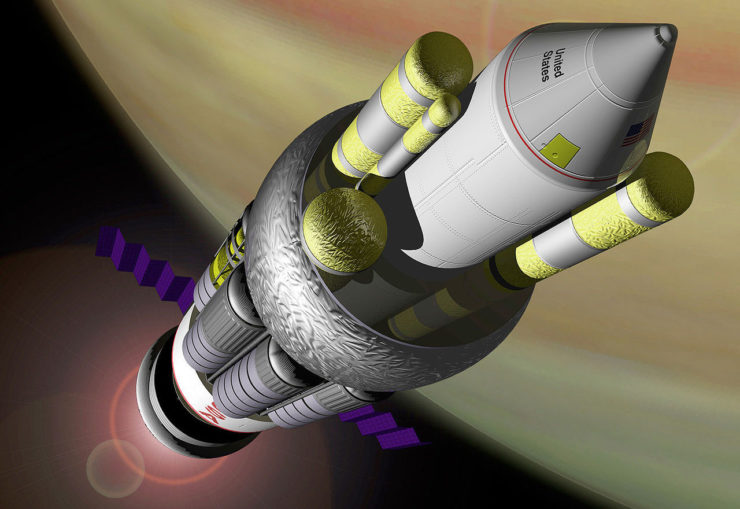Nuclear explosives can be used to address many urgent issues: a shortage of mildly radioactive harbours, for example, or the problem of having too many wealthy, industrialized nations not populated by survivors who envy the dead. The most pressing issue—the need for a fast, affordable space drive—wasn’t solved until the late 1950s. Theodore B. Taylor and others proposed that the Bomb could be used to facilitate rapid space travel across the Solar System. Thus, Project Orion was born.
The design of the Orion rocket is straightforward: detonate a series of nuclear explosives behind a pusher plate. The effective exhaust velocity would be much higher than any chemical rockets could provide. Unlike most plausible propulsion systems, the Orion could provide both high thrust with high exhaust velocity. At least, this is the way it would work in theory. For various reasons, from test ban treaties to the curious disinclination of people to tolerate increasing amounts of fallout, no working Orion was ever built. It remains a pipe dream.
George Dyson’s 2002 book, Project Orion: The True Story of the Atomic Spaceship, is the go-to popular work on Orion.
As any fan of Canada’s Avro Arrow could tell you, no machine is ever as splendid as the ones that have been proposed but never built. Fans can embrace all the potential of the hypothetical without worrying about any of the pesky problems that would certainly crop up in the real world. It is not surprising, therefore, that Orion rockets, many far more effective than the ones Taylor and company proposed, began to show up in science fiction as soon as the concept became public knowledge.
Take, for example, these Disco- and Reagan-era novels—memories of a time when SF was surprisingly keen on the idea of traveling on top of a stack of exploding atomic bombs.
***
Farthest Star by Frederik Pohl and Jack Williamson (1975)
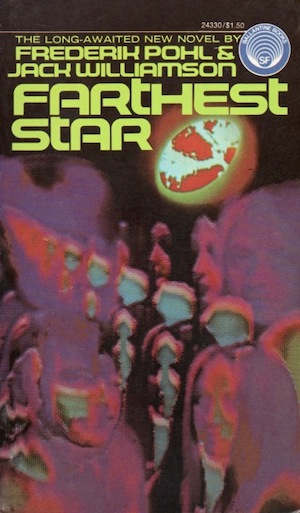
Object Lambda, an object as massive as a star, is passing through the Milky Way at a significant fraction of the speed of light. This demands investigation. Providentially, galactic civilizations can beam explorers across the Milky Way in the blink of an eye—provided the correct machinery is first delivered to the destination at sub-light speeds. The good ship Aurora has been diverted to deliver receivers to the enigmatic artifact.
Ben Perrin has the privilege to represent humanity on Aurora. This is a mixed blessing because among the amenities not present on the Orion-style craft is radiation shielding. Aurora provides its crew with abundant radiation. Thus, service is also a death sentence.
Not to worry. The marvelous technology Aurora will deliver to Lambda isn’t a teleport station; it’s a matter duplicator. If the current Ben Perrin should die—and given enough time on Aurora, he will—the authorities will simply run off as many copies as are needed to complete the mission. After all, it’s not as though the original Ben who volunteered for the suicide mission is the Ben who will die.
***
King David’s Spaceship by Jerry Pournelle (1980)
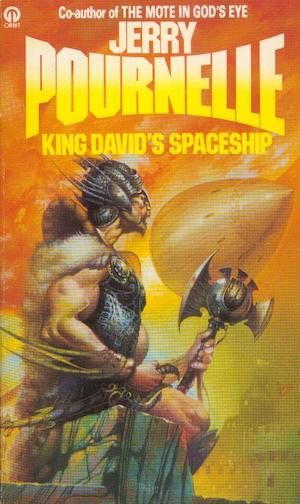
In the wake of the collapse of the First Empire, Prince Samual’s World balkanized into warring states armed with technology far inferior to that of the First Empire. The Second Empire is now ready to reintegrate Prince Samual’s World into an interstellar community. Thanks to technological disparities, how Prince Samual’s World’s population feels about becoming part of the Empire is irrelevant.
While they have no choice about being conquered by the Second Empire, precisely what status Prince Samual’s World will enjoy within the Empire is unclear. Worlds without indigenous space travel are relegated to the status of colonies. Worlds with indigenous space travel enjoy a far loftier position.
Prince Samual’s World’s steam-age technology isn’t up to space travel and the deadline when their world will be assessed looms. Without the time to develop space flight from scratch, Colonel Nathan “Iron” MacKinnie is dispatched to Makassar, where rumour has it that a First Empire library survives. Perhaps the library has some brute-force solution to orbital launches that is within Prince Samual’s World’s limited capacity. But time is running out and the backward natives of Makassar are disinclined to allow off-worlders to enter what is to them a holy site.…
***
Orion Shall Rise by Poul Anderson (1983)
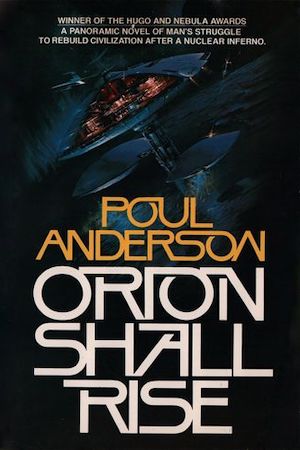
Centuries after the thermonuclear Downfall put an end to Western civilization, the world is well on its way to recovering the technology of the lost world. Technological sophistication is not matched by social progress—large swaths of the world are feudal states—while the exuberant industrialization of the 20th century depleted easy-to-reach natural resources. Thus, the civilizations of this world cannot easily recover the security and luxuries of the past.
The Maurai Federation believes industrialization was a mistake. It resulted in a poorer, poisoned world. As the world’s predominant power, they are in a position to make their stance general policy. When other nations try to upgrade, the Maurai step in to curtail the effort before it grows out of hand.
The Northwest Union learned this the hard way; it has been forced to heed Maurai taboos despite the Northwest’s current technological edge and urge to take it further. Determined to break free of Maurai shackles, the Union sets out to recreate a world-changing technology based in ancient myth. All they need is time and a sufficient supply of forbidden fissionables. And if there was one thing the old world was good at, it was leaving caches of lethal material scattered across America. Pity so much of North America is enemy territory…
***
Emprise by Michael Kube-McDowell (1985)
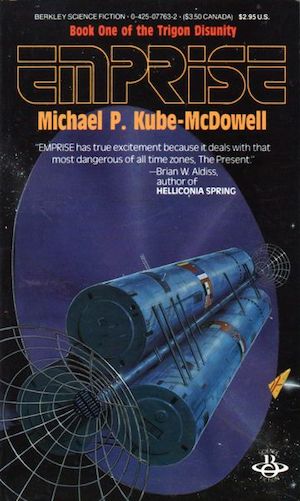
The Weak Force Intermodulation Projector—AKA the fission blanket—freed the world from the threat of thermonuclear war. The fission blanket also liberated the world from the easiest replacement for dwindling fossil fuel supplies. The Food and Fuel Wars that followed were arguably only superior to nuclear war because they didn’t leave the world poisoned by fallout. People still died in the hundreds of millions, and nations were still shattered.
A world emerging from a brief dark age is astounded to receive a message from the stars. Earth is about to have an extra-solar visitor, in the form of a nuclear-pulse-driven starship. A balkanized world would be ill-suited to resist the enigmatic visitors should they prove hostile. Nothing for it, therefore, but for a broken world to find some way to present a united face to the mysterious Galactics.
***
Marooned in Realtime by Vernor Vinge (1986)
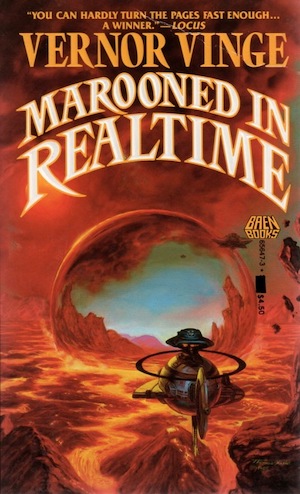
The Peace Authority used bobbles—spheres of frozen time—to conquer the world in the name of peace. Long after the Authority’s fall, humanity uses the bobbles in far more creative ways. Bobble-equipped Orion-style rockets can, for example, withstand the nuclear explosions of their propulsion systems and protect the passengers from the passage of time during long trips. Cheap, convenient space travel is just one aspect of the wonders of late humanity.
Pity that those cunning humans went extinct.
A handful of survivors protected within bobbles evaded whatever erased humans. They are equipped with impressively advanced technology, which doesn’t compensate for their dwindling numbers…because it seems an ancient human habit has made its way into the far future: murder.
***
I have no doubt many of you have your own favourite examples of fictional Orion drives—the only kind we have—and are even now preparing to descend on me for overlooking them. Have at it in the comments below.
In the words of Wikipedia editor TexasAndroid, prolific book reviewer and perennial Darwin Award nominee James Davis Nicoll is of “questionable notability.” His work has appeared in Publishers Weekly and Romantic Times as well as on his own websites, James Nicoll Reviews and Young People Read Old SFF(where he is assisted by editor Karen Lofstrom and web person Adrienne L. Travis). He is a four-time finalist for the Best Fan Writer Hugo Award and is surprisingly flammable.










